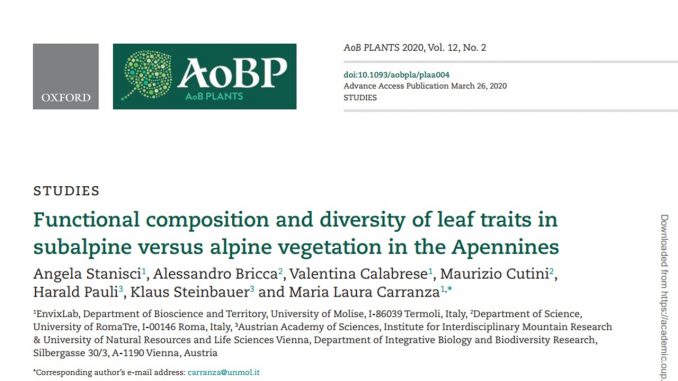
Mediterranean high mountain grasslands are shaped by climatic stress and understanding their functional adaptations can contribute to better understanding ecosystems’ response to global change. The present work analyses the plant functional traits of high-elevation grasslands growing in Mediterranean limestone mountains to explore, at the community level, the presence of different plant strategies for resource use (conservative vs. acquisitive) and functional diversity syndromes (convergent or divergent). Thus, we compared the functional composition and diversity of the above-ground traits related to resource acquisition strategies of subalpine and alpine calcareous grasslands in the central Apennines, a mountain region characterized by a dry-summer Mediterranean climate. We used georeferenced vegetation plots and feld-measured plant
functional traits (plant maximum height, specifc leaf area and leaf dry matter content) for the dominant species of two characteristic vegetation types: the subalpine Sesleria juncifolia community and the alpine Silene acaulis community. Both communities are of particular conservation concern and are rich in endemic species for which plant functional traits are measured here for the frst time. We analysed the functional composition and diversity using the community-weighted mean trait index and the functional diversity using Rao’s function, and we assessed how much the observed pattern deviated from a random distribution by calculating the respective standardized effect sizes. The results highlighted that an acquisitive resource use strategy and relatively higher functional diversity of leaf traits prevail in the alpine S. acaulis community, optimizing a rapid carbon gain, which would help overcome the constraints exerted by the short growing season. The divergent functional strategy underlines the coccurrence of different leaf traits in the alpine grasslands, which shows good adaptation to a microhabitat-rich environment. Conversely, in the subalpine S. juncifolia grassland, a conservative resource use strategy and relatively lower functional diversity of the leaf traits are likely related to a high level resistance to aridity over a longer growing season. Our outcomes indicate the preadaptation trategy of the subalpine S. juncifolia grassland to shift upwards to the alpine zone that will become warmer and drier as a result of anthropogenic climate change

Commenta per primo